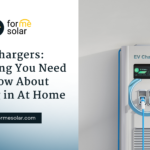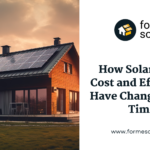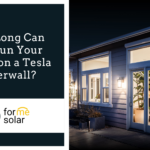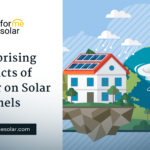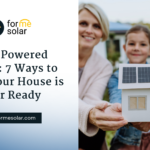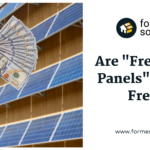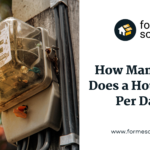
Table of Contents
Solar Loans: Everything You Need to Know
Thinking about getting solar power? You're probably sorting through the various ways to pay for it. You could outright own the system by paying cash upfront, rent the panels from the installation company, or go for a solar loan – which is what most people do. Dealing with loans can be a bit tricky, and solar loans are no different! In this article, we're going to guide you through the basics of financing solar power and help you figure out which solar loan suits you best.
What is a Solar Loan?
Have you ever acquired a loan to renovate your home? Solar panel loans function similarly to home renovation loans, which individuals use to accomplish things like building a deck, upgrading their air conditioning, or installing new bathrooms. When you take out a loan from a lender to finance your solar panels, you are agreeing to pay it back, plus interest, every month for a defined period of time.
These solar panel loans have some similarities with other loans you've seen. When looking at solar financing possibilities, it's important to consider all aspects of the loan, including:
Loan term: the maximum timeframe for making payments on the loan.
The interest rate, often known as the APR: is the amount that lenders charge for borrowing money.
Fees: are any additional costs imposed by the lender at the time of loan start.
We will go into further detail about these subjects below.
Principal
Alright, let's talk about the big boss in your loan world – the principal. This is the starting size of your loan, the money your lender hands over to make your solar dreams come true. Imagine it as the total bill for your solar setup if you bought it upfront with your own cash stash. Now, as you chip away at your loan, the principal is what you still owe.
Want to speed things up? You can make principal payments to slash the overall cost and trim down the time it takes to clear your debt. Keep an eye out for quotes that show a different price for cash and financing – that usually means there are some sneaky fees in your loan mix. When in doubt, give your installer a shout to clear up any mysteries between cash and financed prices.
Financing Term
The financing term, often referred to as the "loan contract," "loan length," or "loan term," is the maximum amount of time you will be making payments on your loan. This phrase has a big impact on important things like your interest rates, how much you have to pay each month, and how much your solar panels will return altogether (ROI).
For example, if your solar loan was originally for $20,000 and you paid $7,000 on it initially, the remaining principal balance would be $13,000. This means that you will only pay interest on the $13,000, which will lower the total amount of interest you pay back throughout the loan's duration.
Interest rate and APR
People sometimes mix up interest and annual percentage rates (APR). When you look at your loan papers, especially depending on your lender and the loan type, you might find percentages for both APR and interest rate. If that happens, the APR usually looks bigger than the interest rate because it covers extra loan fees.
Now, let's simplify it:
APR, or annual percentage rate, is the yearly expense of borrowing money, shown as a percentage.
On the other side, the interest rate is what you pay to borrow cash from a lender to fund your solar panel system, also expressed as a percentage.
Fees
Usually, there are two types of fees associated with solar loans: origination/dealer fees and closing costs. Similar to origination fees on house loans, origination or dealer fees are the most prevalent fees associated with solar financing. Fees may be expressed as a percentage of your overall solar loan amount or as a fixed sum.
Origination/dealer fee: Sometimes solar lenders impose an additional cost to offset their lending risk. This is sometimes referred to as an initiation fee, loan fee, or lender fee. Since there is no industry-wide dealer fee, the amount will differ based on the lender.
Closing costs: Occasionally, you may see closing costs stated on your solar loan. These costs are comparable to origination fees in that they cover the risk the lender assumes when closing on the loan.
How To Choose a Solar Loan?
Your loan term will determine your monthly payment, interest rate, and total cost of solar panels. As a result, it's critical to choose wisely and get a loan term that works for you. Longer loan terms come with higher interest rates, which means you'll have to pay more for your solar system. However, you may prefer a longer-term loan if your goal is to reduce your monthly electric expenses and replace your electric bill with a solar loan payment.
Long-term or short-term loan: which one is the better pick for you?
| Long Term Loan | Short Term Loan |
| A higher interest rate | Reduced interest rate |
| Reduced monthly payments (as you'll be spreading them out over an extended period) | Higher monthly installments (because you'll make less payments overall) |
| Increased total cost of ownership | Reduced overall ownership costs |
| Potential immediate savings: ideal for cutting down your monthly electric costs or swapping your utility bill for a solar loan | Long-term savings are greatest for optimizing solar energy savings and enhancing return on investment. |
Most solar loans have payment periods ranging from five to twenty years. The specific time frame varies depending on the lender, loan terms, and the borrower's choices. Shorter loan periods often have higher monthly payments but lower overall interest expenses, whereas longer loan terms may have lower monthly payments but result in greater total interest paid over the life of the loan. When deciding on the optimal loan term for a person's requirements, it all comes down to their own financial objectives and circumstances.
Should You Choose the Loan with The Lowest Interest?
If you've previously shopped around for a loan for your house or car, your eye may be conditioned to look for the one with the lowest interest rate. different lenders offer different rates of interest. To guarantee you obtain the greatest deal and the loan that best suits your needs, it's crucial to take into account all the elements covered above when looking for solar loans, not just the interest rate.
Dealer or initiation fees are occasionally used by solar lenders to artificially lower the interest rates on their loan packages. Stated differently, their ability to impose lower interest rates stems from their greater upfront payments.
It's important to check your bids and question installers about any discrepancies in cash and financed pricing since dealer fees, which may reach up to 30% of the loan amount, are sometimes hidden. Your solar panel system will cost 30% more even with a low-interest rate, so any savings you could have by choosing a loan with a lower interest rate would be lost. Instead of comparing only interest rates when weighing your financing alternatives, we advise you to take into account the overall cost of ownership of your solar panels. Interest rates on loans without dealer fees might be higher.
Most solar loans fall into one of two main categories: secured or unsecured loans. When you take out a secured loan, your lender will place a lien on your property and demand an item to act as collateral. Typically, this asset is your home. Conversely, unsecured loans just demand the solar equipment itself as security.
Solar Loan Options
Like any other financial choice, solar loans come in a variety of packages with different conditions, restrictions, and structures. Let's examine some factors to take into account while locating the best solar energy loan:
Secured vs. unsecured loans
Most solar loans fall into two categories: secured loans and unsecured loans. Secured loans require an asset to serve as collateral for the loan; in most circumstances, that asset is your home, and your lender will place a lien on it. In contrast, unsecured loans do not require any security other than the solar equipment itself.
| Secured Loan | Unsecured Loan |
| Pros: Lower interest ratesRelaxed eligibility requirementsLarger loan amountsHelps to build your credit score | Pros: No risk of losing collateralBetter flexibilityFaster application and approval process |
| Cons: Risky for your credit scoreBorrowers risk losing their collateralCan come with restrictions on loan usage | Cons: Strict eligibility criteriaHigher interest ratesCan come with hidden feesSmaller loan amounts |
Amortized vs. re-amortized solar loans
Your solar loan will be amortized or re-amortized; each option has advantages and disadvantages. Most secured loans are amortized, which means you have a fixed monthly payment and period. Most unsecured loans, on the other hand, are re-amortized, which means you pay a large sum after a set period of time (typically one year), and then your payments gradually decrease after that.
Where Can You Get a Solar Loan?
In recent years, solar loans have grown more widely available, and the number of banks and other organizations providing solar loans has been steadily expanding!
In the event that a solar installer has already provided you with an estimate, they will probably present you with several different financing alternatives. In this case, the installer serves as a helpful counselor as well as a resource for solar system installation, guiding you through the range of possible financing alternatives. This move toward greater accessibility allows people who are thinking about solar energy to look at a variety of financing options and customize the financing to best fit their unique requirements and preferences.
Credit unions: Homeowners can apply for energy loan products from regional banks and credit unions around the nation. Here you'll frequently discover some of the best, most affordable loan alternatives available!
National lending institutions: major banks are embracing solar energy as it gains popularity. Nowadays, a lot of them provide specialized financing options designed for homes with solar energy systems.
Public-private partnerships: To provide solar loans with reduced interest rates and no fees, local government organizations frequently collaborate with private lenders.
Utilities: You may finance solar energy systems and pay back the borrowed amount as part of your monthly power bills through various competitive on-bill financing options offered by utility providers.
Municipalities: Property Assessed Clean Energy (PACE) solar energy funding is accessible in certain municipalities, while it's not available in all states. A yearly assessment appears on your property tax bill when you use a PACE loan to fund a system.
Specialized solar lenders: A lot of businesses now focus only on offering solar loan options. To provide financing, they collaborate with banks and a group of solar installers.
Bottom Line: Are Solar Loans a Wise Choice?
Solar loans might be an excellent method to pay for solar panels. If you can create a loan with a monthly payment that is less than or equal to the average monthly savings generated by the solar system, you will be cash flow positive from the beginning.
However, it is still vital to use caution while dealing with money. Some unethical solar installers and/or lenders price their systems such that the monthly loan payment is about equal to the energy bill savings provided by the solar installation. This might imply that the system costs substantially more than it would if the homeowner paid cash or bought it someplace with lower power prices.
Find a solar loan with a fair dealer fee and interest rate, if that's possible. It's critical to realize that lower interest rates correspond with greater dealer fees and vice versa. You may need to compare financing alternatives for this. To discover the best value, Forme Solar recommends obtaining at least three quotes from several businesses so you can find the best deal possible.


